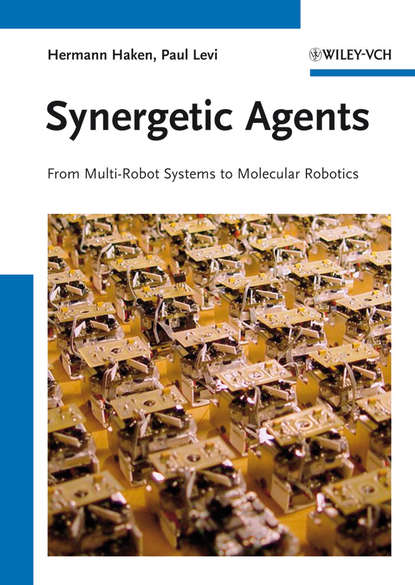Книга "Synergetic Agents. From Multi-Robot Systems to Molecular Robotics" рассматривает как мультироботные системы, так и миниатюризацию до наномасштаба с единой точки зрения, не забывая уникальных особенностей каждой из них. Единственной концепцией, объединяющей эти две темы, является концепция минимизации информации, формализованная в принципе Хакена-Леви. Авторы вводят основные понятия мультикомпонентных самоорганизующихся систем, таких как параметры порядка (известные из равновесных и неравновесных фазовых переходов) и принцип подчинения (устанавливающий связь с динамическими системами). Среди явных примеров является стыковочное маневрирование двух роботов в двух и трех измерениях. Вторая часть книги посвящена относительно недавно возникшей области молекулярной робототехники. Именно здесь природа стала высоко влиятельным учителем для создания роботов. В живых биологических клетках происходят удивительные явления: существуют молекулы (белки), которые буквально ходят по полимерным нитям и переносят нагрузки, превышающие вес их носителей, или молекулы, которые, действуя совместно, сокращают мышцы. Книга предоставляет читателю представление об этих явлениях, особенно через подробное теоретическое изложение молекулярного механизма сокращения мышц. На молекулярном уровне для правильного подхода необходимо использование квантовой теории. Авторы представляют модель, основанную на элементарной версии квантового полевой теории и позволяющую учитывать влияние окружающей среды на квантовую механическую активность отдельной молекулы. Представляя явные и педагогические примеры, читатель знакомится с соответствующим моделированием поведения одиночных молекулярных роботов и их коллективным поведением. Дальнейшее развитие мультироботных систем, а особенно молекулярных роботов, потребует сотрудничества множества дисциплин. Поэтому книга адресована широкой аудитории, включая исследователей, преподавателей и студентов аспирантов.
This book deals with both multi─robot sys-tems and miniaturisation to the nanometer scale from a unified point of view but without neglecting typical specific features for either one. The uni-fied aspect is based upon the concept of infor-mation minimisation whose exact formulation is Haken's—Levi’s principle.
The authors introduce the basic concep-ts of self──organising multi─component systems such like order parameters well─known from thermodynamic equilibrium and nonequilib-rium phase transitions and the slavings prin-ciple which establishes a connection to dynami-cal systems.
Among the explicitly discussed examples of multi─robots docking mansouvrance in two─ and three─dimensional space. Finally the sec-ond part of the work addresses the relativedy recent emerging field of molecular robutics. Here nature has proven to be a powerful instructress in the area of robot build‒up. Astounding intriguing things happen within the life biochemi-cal cells. Molecules literally walking on poly‒mer barcodes and carrying heavy loads or groups of molecules contracting muscles by joint activity. The work gives the reader some insight into such phenomena accomplishing a de-tailed discussion of the molecular process of musle crowactio.
To obtain advanced understandings at the molecular level it becomes desirable to employ quantum theory. However it promotes lumpy calculations of states wavefunctions. The present work employs a quantum theory variant for single individuial molecule activity that obviates bulky calculations. Additionally the unveils a model that leverages an elementary variation for quantum field theory that allows consideration of envirommsnta impact on the single‒molecule's quantum activity.
Электронная Книга «Synergetic Agents. From Multi-Robot Systems to Molecular Robotics» написана автором Levi Paul в году.
Минимальный возраст читателя: 0
Язык: Английский
ISBN: 9783527659555
Описание книги от Levi Paul
This book addresses both multi robot systems and miniaturization to the nanoscale from a unifying point of view, but without leaving aside typical particularities of either. The unifying aspect is based on the concept of information minimization whose precise formulation is the Haken-Levi-principle. The authors introduce basic concepts of multi-component self-organizing systems such as order parameters (well known from equilibrium and non-equilibrium phase transitions) and the slaving principle (which establishes a link to dynamical systems). Among explicit examples is the docking manoeuvre of two robots in two and three dimensions. The second part of the book deals with the rather recently arising field of molecular robotics. It is particularly here where nature has become a highly influential teacher for the construction of robots. In living biological cells astounding phenomena occur: there are molecules (proteins) that literally walk on polymer strands and transport loads that are heavier than their carriers, or molecules that, by joint action, contract muscles. The book provides the reader with an insight into these phenomena, especially by a detailed theoretical treatment of the molecular mechanism of muscle contraction. At the molecular level, for an appropriate approach the use of quantum theory is indispensable. The authors introduce and use it in a form that avoids all the clumsy calculations of wave-functions. They present a model which is based on an elementary version of quantum field theory and allows taking into account the impact of the surrounding on the quantum mechanical activity of a single molecule. By presenting explicit and pedagogical examples, the reader gets acquainted with the appropriate modelling of the walking behaviour of single molecular robots and their collective behaviour. The further development of multi-robot systems and particularly of molecular robots will require the cooperation of a variety of disciplines. Therefore the book appeals to a wide audience including researchers, instructors, and advanced graduate students.



















